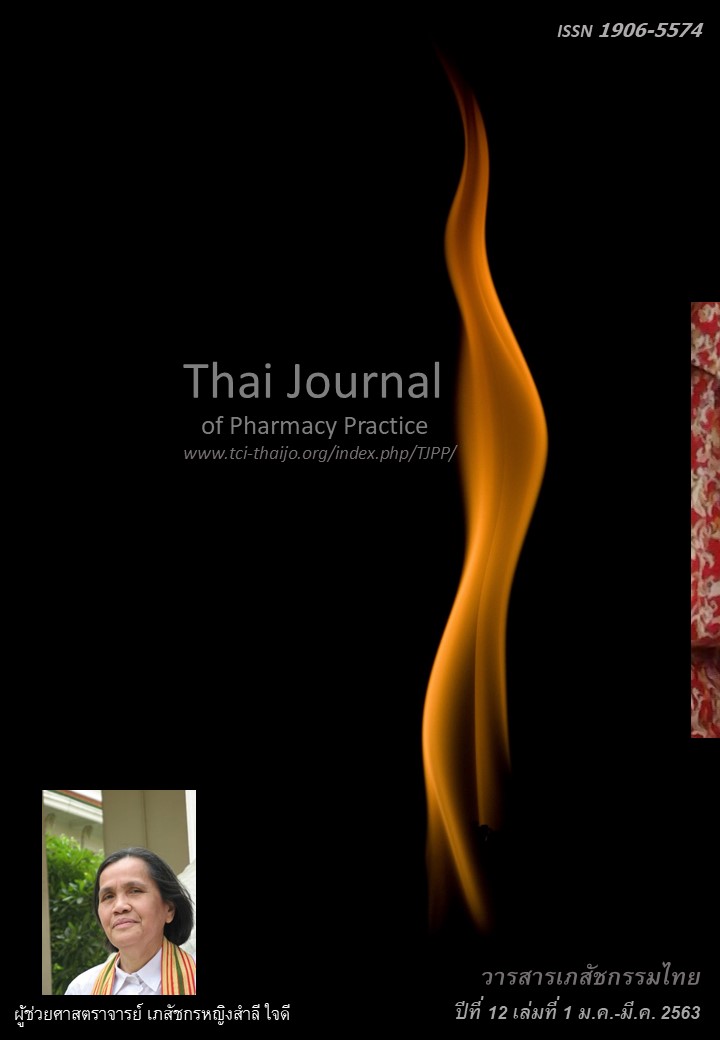โอกาสเสี่ยงของการแพ้ยาซ้ำที่เป็นการแพ้ยาเทียมในยาต้านการอักเสบ ชนิดที่ไม่ใช่สเตียรอยด์ในโรงพยาบาลชลบุรี
Main Article Content
บทคัดย่อ
วัตถุประสงค์: เพื่อหาอัตราการเกิดและโอกาสเสี่ยงของการแพ้ยาซ้ำกลุ่มยาต้านการอักเสบชนิดที่ไม่ใช่สเตียรอยด์ (nonsteroidal anti-inflammatory drugs; NSAIDs) ด้วยปฏิกิริยาแพ้ยาเทียม วิธีการ: รูปแบบงานวิจัยเป็นการศึกษาแบบภาคตัดขวางที่เก็บข้อมูลย้อนหลังจากรายงานการแพ้ยากลุ่ม NSAIDs ของโรงพยาบาลชลบุรีตั้งแต่ 1 มกราคม พ.ศ. 2554 ถึง 31 ธันวาคม พ.ศ. 2559 การศึกษาหาความสัมพันธ์ระหว่างชนิดของยากับการแพ้ ผลการวิจัย: การศึกษาพบรายงานอาการไม่พึงประสงค์จากการใช้ยา (ADR) ของยา NSAIDs จำนวน 493 รายงาน จากรายงานทั้งหมด 18,674 รายงาน (ร้อยละ 2.64) ทั้งนี้พบอาการ angioedema และ anaphylaxis 281 รายงาน (ร้อยละ 57.0 ของรายงาน ADR จาก NSAIDs ทั้งหมด) ยากลุ่ม arilpropionic acids มีรายงานมากที่สุด 272 รายงาน (ร้อยละ 54.8 ของรายงาน ADR จาก NSAIDs ทั้งหมด) ตามด้วยยากลุ่ม hetero acetic acids จำนวน 104 รายงาน (ร้อยละ 23.1) โครงสร้างของยา NSAIDs ที่แตกต่างกันมีความสัมพันธ์กับ ADR ทางผิวหนัง (P<0.05) จากรายงานการแพ้ยา NSAIDs ทั้งหมด พบการแพ้ยาเทียม 49 รายงาน (ร้อยละ 9.34 ของรายงาน ADR จาก NSAIDs ทั้งหมด) การแพ้ครั้งแรกพบในยากลุ่ม hetero acetic acids มากที่สุด 10 รายงาน (ร้อยละ 43.5 ของการแพ้ยาครั้งแรก) โดยเฉพาะจากยา diclofenac การแพ้ยาในครั้งต่อมาพบรายงานกลุ่มยา arilpropionic acids ได้แก่ ยา ibuprofen และ ยา naproxen มากที่สุด (ร้อยละ 53.8) ส่วนยากลุ่ม Cox II inhibitor ได้แก่ ยา celecoxib และยา etoricoxib พบ ADR ทางผิวหนัง 28 รายงาน (ร้อยละ 5.7) และเป็นการเกิดการแพ้ยาเทียม 4 รายงาน (ร้อยละ 8.16 จากรายงานการแพ้ยาเทียมทั้งหมด) สรุป: อัตราการเกิดการแพ้ยาเทียมพบประมาณร้อยละ 10 ของการใช้ยากลุ่ม NSAIDs ดังนั้นเพื่อลดโอกาสเสี่ยงของการแพ้ยาเทียม จึงควรมีการซักประวัติอย่างละเอียดและติดตามการแพ้ยาอย่างใกล้ชิดในผู้ที่ใช้ยา NSAIDs กลุ่มต่าง ๆ
Article Details
ผลการวิจัยและความคิดเห็นที่ปรากฏในบทความถือเป็นความคิดเห็นและอยู่ในความรับผิดชอบของผู้นิพนธ์ มิใช่ความเห็นหรือความรับผิดชอบของกองบรรณาธิการ หรือคณะเภสัชศาสตร์ มหาวิทยาลัยสงขลานครินทร์ ทั้งนี้ไม่รวมความผิดพลาดอันเกิดจากการพิมพ์ บทความที่ได้รับการเผยแพร่โดยวารสารเภสัชกรรมไทยถือเป็นสิทธิ์ของวารสารฯ
เอกสารอ้างอิง
2. Kongkaew C, Noyce PR, Ashcroft DM. Hospital admissions associated with adverse drug reactions: a systematic review of prospective observational studies. Ann Pharmacother. 2008;42:1017-25.
3. Aun MV, Blanca M, Garro LS, Ribeiro MR, Kalil J, Motta AA, et al. Nonsteroidal anti-inflammatory drugs are major causes of drug-induced anaphy laxis. J Allergy Clin Immunol Pract. 2014;2:414-20.
4. Techapornroong M, Akrawinthawong K, Cheungpa sitporn W, Ruxrungtham K. Anaphylaxis: a ten years inpatient retrospective study. Asian Pac J Allergy Immunol. 2010;28:262-9.
5. Helbling A, Hurni T, Mueller U, Pichler W. Incidence of anaphylaxis with circulatory symptoms: a study over a 3‐year period comprising 940000 inhabitants of the Swiss Canton Bern. Clin Exp Allergy. 2004; 34: 285-90.
6. Benkirane R, Pariente A, Achour S, Ouammi L, Azzouzi A, Soulaymani R. Prevalence and preventa bility of adverse drug events in a teaching hospital: a cross-sectional study. East Mediterr Health J. 2009;15:1145-55.
7. Demoly P, Bousquet J. Epidemiology of drug allergy. Curr Opin Allergy Clin Immunol. 2001;1:305-10.
8. Zhang B, Li Q, Shi C, Zhang X. Drug-induced pseudoallergy: a review of the causes and mecha nisms. Pharmacology. 2018;101: 104-10.
9. Wang H, Wang H, Liu Z. Agents that induce pseudo-allergic reaction. Drug Discov Ther. 2011;5: 211-9.
10. Demoly P, Lebel B, Messaad D, Sahla H, Rongier M, Daures J, et al. Predictive capacity of histamine release for the diagnosis of drug allergy. Allergy. 1999;54:500-6.
11. Weberschock TB, Müller S-M, Boehncke S, Boehncke W-H. Tolerance to coxibs in patients with intolerance to non-steroidal anti-inflammatory drugs (NSAIDs): a systematic structured review of the literature. Arch Dermatol Res. 2007;299:169-75.
12. Simon RA. NSAIDs (including aspirin): Allergic and pseudoallergic reactions 2015 [online]. 2015 [cited July 12, 2019]. Available from: www.uptodate.com /contents/nsaids-including-aspirin-allergic-and-pseu doallergic-reactions.
13. Health product vigilance center (HPVC). Sponta neous reports of adverse drug reactions 2017. Nonthaburi: Food and Drug Administration, Ministry of Public Health; 2018.
14. Tan V, Gerez I, Van HB. Prevalence of drug allergy in Singaporean children. Singapore Med J. 2009; 50: 1158-61.
15. Luanghirun P, Tanaboriboon P, Mahissarakul P, Lertvivatpong N. Prevalence and associated factors of regular nonsteroidal anti-inflammatory drugs used in a rural community, Thailand. Glob J Health Sci. 2017; 9: 58.
16. Wehling M. Non-steroidal anti-inflammatory drug use in chronic pain conditions with special empha sis on the elderly and patients with relevant comor bidities: management and mitigation of risks and adverse effects. Eur J Clin Pharmacol 2014; 70: 1159-72.
17. Kowalski M, Makowska J, Blanca M, Bavbek S, Bochenek G, Bousquet J, et al. Hypersensitivity to nonsteroidal anti‐inflammatory drugs (NSAIDs)–classification, diagnosis and management: review of the EAACI/ENDA# and GA2LEN/HANNA. Allergy. 2011;66: 818-29.
18. Van Puijenbroek EP, Egberts AC, Meyboom RH, Leufkens HG. Different risks for NSAID-induced anaphylaxis. Ann Pharmacother. 2002;36:24-9.
19. Sylvia L, DiPiro J. Allergic and pseudoallergic drug reactions. Pharmacotherapy: A pathophysiologic approach. 8th ed. New York: McGraw-Hill; 2011.
20. Fontaine C, Bousquet PJ, Demoly P. Anaphylactic shock caused by a selective allergy to celecoxib, with no allergy to rofecoxib or sulfamethoxazole. J Allergy Clin Immunol. 2005;115:633-4.
21. Habki R, Vermeulen C, Bachmeyer C, Charoud A, Mofredj A. Anaphylactic shock induced by celecoxib. Ann Med Interne (Paris). 2001;152:355.


